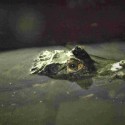
Spectacled Caiman Natural History
Size
Males can grow from 6 ft to 8.5 ft (2m to 2.5m) whilst females generally do not exceed 4.5 ft (1.4m). The body mass of most adult Spectacled Caimans is between 7 and 40 kg.
Habitat and Distribution
These crocodilian reptiles spend most of their time in the water or basking along the banks of rivers and lakes.
This caiman’s natural range is spread around areas of Central and Southern America covering Mexico and Downwards through Guyana, Peru, Honduras, Columbia, Surinam, Panama and through to Northern areas of Brazil.
They do however also have an introduced range in Cuba, Costa Rica and Florida in the USA.
Age
Their lifespan in captivity generally reaches around 25 years.
Diet
As babies these caimans feed off invertebrates found around their bodies of water, however as they increase in size, more of their diet will be made up of fish, small to medium sized mammals, birds and reptiles.
Groups and Breeding
Areas where Spectacled Caimans live often have high population densities and breeding takes place from May to August after extensive courtship displays.
Females are sexually mature from around 7 years of age after which they can lay clutches of 14 to 40 eggs once per year. These eggs will hatch out after around 90 days.
Threats
This species has a fairly healthy population in the wild even though it is collected for the pet trade and relatively highly hunted for its skin. Young caiman may become occasional prey for large snake species such as anacondas, however other than those it has very few natural predators.
Interesting Facts
If the areas of water in their range become too dried out to hunt efficiently, they can decrease their metabolic rate drastically allowing them to rest without food for longer periods until the wet season starts again.
The Spectacled Caiman During Your Day Out in Kent
The two Spectacled Caiman at Wingham Wildlife Park can be seen in our Reptile House next to the Green Iguanas and Alligator Snapping Turtle. The Reptile House is also home to a number of other species including several snake, turtle, and lizard species plus a variety of amphibians.
Our keepers feed them rats, rabbit and chicken here at the park.